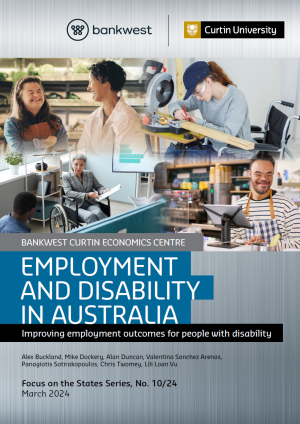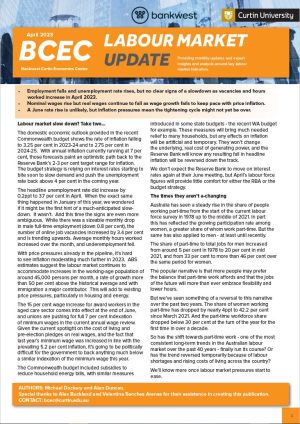BCEC Monthly Labour Market Update – April 2023
— Employment falls and unemployment rate rises, but no clear signs of a slowdown as vacancies and hours worked increase in April 2023. —
— Nominal wages rise but real wages continue to fall as wage growth fails to keep pace with price inflation. —
— A June rate rise is unlikely, but inflation pressures mean the tightening cycle might not yet be over. —
Labour market slow down? Take two…
The domestic economic outlook provided in the recent Commonwealth budget shows the rate of inflation falling to 3.25 per cent in 2023-24 and to 2.75 per cent in 2024-25. With annual inflation currently running at 7 per cent, those forecasts paint an optimistic path back to the Reserve Bank’s 2-3 per cent target range for inflation. The budget strategy is relying on interest rates starting to bite soon to slow demand and push the unemployment rate back above 4 per cent in the coming year.
The headline unemployment rate did increase by 0.2ppt to 3.7 per cent in April. When the exact same thing happened in January of this year, we wondered if it might be the first hint of a much-anticipated slow-down. It wasn’t. And this time the signs are even more ambiguous. While there was a sizeable monthly drop in male full-time employment (down 0.8 per cent), the number of online job vacancies increased by 3.4 per cent and is trending upwards. Average monthly hours worked increased over the month, and underemployment fell.
With price pressures already in the pipeline, it’s hard to see inflation moderating much further in 2023. ABS estimates suggest the labour market continues to accommodate increases in the working-age population of around 45,000 persons per month, a rate of growth more than 50 per cent above the historical average and with immigration a major contributor. This will add to existing price pressures, particularly in housing and energy.
The 15 per cent wage increase for award workers in the aged care sector comes into effect at the end of June, and unions are pushing for full 7 per cent indexation of minimum wages in the current annual wage review. Given the current spotlight on the cost of living and pre-election pledges on real wages, and the fact that last year’s minimum wage was increased in line with the prevailing 5.2 per cent inflation, it’s going to be politically difficult for the government to back anything much below a similar indexation of the minimum wage this year.
The Commonwealth budget included subsidies to reduce household energy bills, with similar measures introduced in some state budgets – the recent WA budget for example. These measures will bring much needed relief to many households, but any effects on inflation will be artificial and temporary. They won’t change the underlying, real cost of generating power, and the Reserve Bank will know any resulting fall in headline inflation will be reversed down the track.
We don’t expect the Reserve Bank to move on interest rates again at their June meeting, but April’s labour force figures will provide little comfort for either the RBA or the budget strategy.
The times they aren’t a-changing
Australia has seen a steady rise in the share of people working part-time from the start of the current labour force survey in 1978 up to the middle of 2021. In part this has reflected the growing participation rate among women, a greater share of whom work part-time. But the same has also applied to men – at least until recently.
The share of part-time to total jobs for men increased from around 5 per cent in 1978 to 20 per cent in mid 2021, and from 33 per cent to more than 46 per cent over the same period for women.
The popular narrative is that more people may prefer the balance that part-time work affords and that the jobs of the future will more than ever embrace flexibility and lower hours.
But we’ve seen something of a reversal to this narrative over the past two years. The share of women working part-time has dropped by nearly 4ppt to 42.2 per cent since March 2021. And the part-time workforce share dropped below 30 per cent at the turn of the year for the first time in over a decade.
So has the shift towards part-time work – one of the most consistent long-term trends in the Australian labour market over the past 40 years – finally run its course? Or has the trend reversed temporarily because of labour shortages and rising costs of living across the country?
We’ll know more once labour market pressures start to ease.




